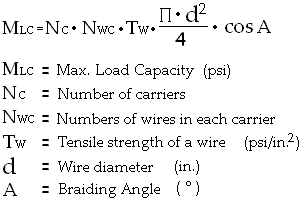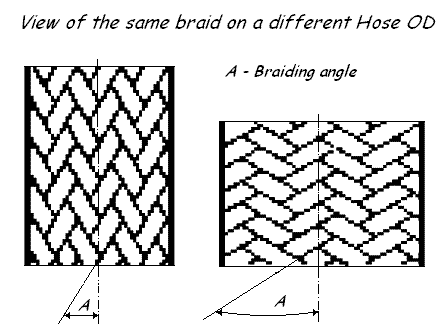Braid: Consideration for Use on a Different Hose OD
Imagine a situation when you received a “next day delivery” order for 3″ assemblies and, by Murphy’s law, have plenty of 2″ and 4″ braid in stock but not a single length of 3″. A few questions might flow through your mind: What if I use one of those sizes on 3″ hose? Will that do? How it will change Max. Working Pressure (or Max. Load Capacity of braid)? How’s braid coverage going change? Well, let’s take a look.
Let’s recall (real quick) some basics about the braid. Braid is a flexible wire sheath surrounding a metal hose that prevents the hose from elongation created by internal pressure. It can also absorb exterior tensile stress and provide general protection of the exterior surface of the hose. Braid is composed of a number of wires wrapped helically around the hose in a basket weave fashion and fixed to the hose at both ends. The angle between crossing wires is usually called the braiding angle.
Maximum Load Capacity of braid depends on a number of parameters such as numbers of carriers, number of wires per carrier, tensile strength of wire and braiding angle. For a single layer of braid Maximum Load Capacity of braid can be calculated by the following formula:

Now, what would change in the braid construction if we put braid on the smaller or larger hose OD? As you would see from the picture below the main parameter that will change is braiding angle.

If you put larger braid on a smaller hose OD, braiding angle will become smaller and if you put smaller braid on a larger hose OD, braiding angle will open up or increase.
From the formula above we can see that if braiding angle would increase Max. Load Capacity of braid (or Max. Working Pressure) would decrease and vice versa. That is, for example, because: cos 40° = 0.77 while cos 50° = 0.64.
Note: For the same braid construction with decrease of braiding angle coverage of the braid will decrease as well, while length of the braid will increase. You should not consider to use braid on a hose OD more than one size up or down.
Table below presents some (theoretical) data for most common sizes of 700 Series Standard Braid which shows how Max. Load Capacity of braid will change if braid is used for a smaller or larger OD of hose:
| WP (psi) |
Cov. (%) |
Angle (°) |
WP (psi) |
Cov. (%) |
Angle (°) |
WP (psi) |
Cov. (%) |
Angle (°) |
WP (psi) |
Cov. (%) |
Angle (°) |
WP (psi) |
Cov. (%) |
Angle (°) |
|
| Braid ID | 2″ | 3″ | 4″ | 5″ | 6″ | ||||||||||
| 2″ | 516 | 89 | 38 | 363 | 78 | 25 | |||||||||
| 3″ | 146 | 97 | 63 | 316 | 85 | 38 | 334 | 90 | 29 | ||||||
| 4″ | 183 | 95 | 52 | 232 | 84 | 38 | 256 | 79 | 31 | ||||||
| 5″ | 161 | 89 | 49 | 191 | 74 | 38 | 189 | 86 | 32 | ||||||
| 6″ | 143 | 80 | 46 | 165 | 90 | 38 | |||||||||
Note: To see how Working Pressure, Coverage or Braiding angle would change if (for example) you would put 4″ Braid on 3″ hose – in the horizontal line for braid ID find a column for 4″ size, then move up the column until the row for 3″ size (in the vertical column on the far left) – and “read” respective numbers: 257, 78, 29.
If you have any questions or comments, please contact us.